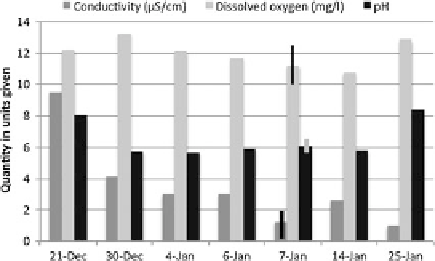Geoscience Reference
In-Depth Information
Fig. 6.9
Conductivity (25
°
C),
dissolved oxygen and pH in
Lake Suvivesi, December
2010
-
January 2011. For
January 7th,
±
standard
deviations are shown by the
narrow columns (Lepp
ä
ranta
et al. 2013b)
The water was very clean in the lake (Fig.
6.9
). The electric conductivity (at 25
°
C
Sm
−
1
and limnologically it was classi
reference) was 1
ed as ultra-oligotrophic. The
water was nearly saturated by oxygen, and pH varied between 6 and 8. Higher values were
due to transport from the nearby nunatak. The lake was extremely low in biota (Keskitalo
et al. 2012).
10
ʼ
-
6.4
Subglacial Lakes
Subglacial lakes, rivers and wetlands are very old water bodies at the base of ice sheet
(e.g. Siegert et al. 2001; Priscu and Foreman 2009). They are very speci
c physical and
microbiological systems at the bottom of the Antarctic ice sheet (Fig.
6.10
), not yet well
known. They were
first found by airborne radio echo sounding. These lakes lie up to
4,200 m under the ice sheet surface, and their length dimension ranges from 1 to 241 km.
The best known is Lake Vostok. Other lakes are found in the Dome C and Ridge B
Atmosphere
Ice flow
Accretion ice
~200 m thick
melt water
refreeze
Liquid water depth
650-800 m
Lake sediments
300-400 m thick
Fig. 6.10
Schematic picture of a subglacial lake



















Search WWH ::

Custom Search